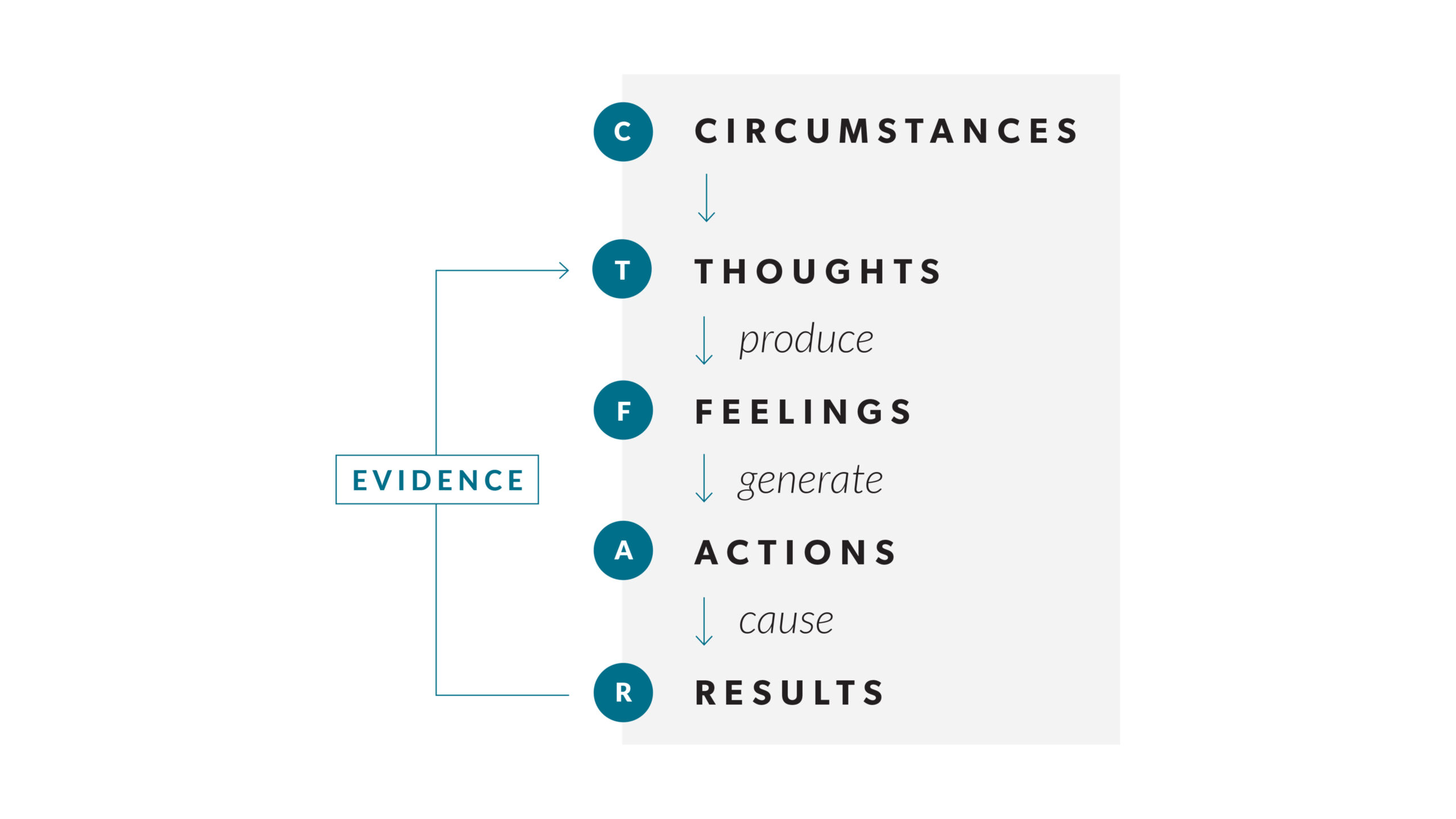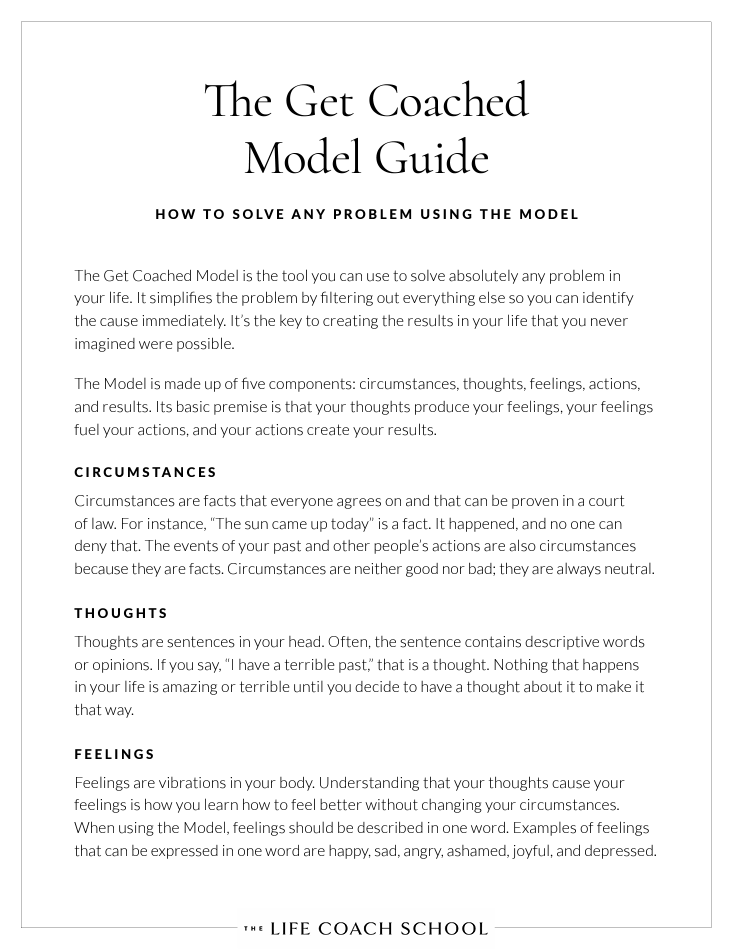What Is the Get Coached Model?
The Get Coached Model is the one tool you need to change anything in your life by helping you understand how your circumstances, thoughts, feelings, actions, and results work.
The Life Coach School Founder and Master Certified Coach Brooke Castillo created The Model to use in her own life… and it was so good, she had to share. Now thousands of people have used the Model to get extraordinary results.
You’re just one model away from everything you ever wanted. What are you waiting for?
The Model Framework
The basic premise of The Model is that your thoughts produce your feelings, your feelings generate your actions, and your actions cause your results.
This is what we help students use and apply to their lives in our self coaching program, Get Coached, to solve their day-to-day problems.

Before we show you how to use The Model in your life, let’s take a look at each component. You can follow along by clicking below to download the worksheet, The Get Coached Model Guide.
Circumstances
Circumstances are facts that can be proven in a court of law. Here is one example: I am 5’5” tall.
The fact that I am a certain height is measurable, provable, and not debatable.
This is how circumstances work. They’re always facts that everyone agrees on and can be proven.
Besides basic facts, there are two additional components to circumstances: your past and other people’s actions. The events of your past are circumstances.
For example, if your mom came over to your house last week at 10 am without calling first, that is a circumstance. It’s a fact. It’s her action. It already happened.
If your mom calls you right now and says she’s coming over, that is also a circumstance. She called and said she’s coming over. It’s a fact that she called, and it’s not debatable by anyone.
Circumstances—the facts of your life—are neutral. That means they’re neither good nor bad. Circumstances only become good or bad based on the thoughts we have about them.
Thoughts
Thoughts are sentences in your head. For example, thinking that your mom is being rude by coming over unannounced is a thought. That is your opinion. Many people could have different opinions about the same circumstance.
You know a thought is a thought and not a circumstance if there are any descriptive words or opinions in the sentence around the facts. Even if 100 people out of 100 agree on something that has an opinion in it, it’s still a thought because it can’t be proven as a fact. The number of people agreeing with a thought doesn’t make it a circumstance. It’s still a thought.
Any time you add a qualifier to a circumstance, you are choosing to think a thought. If you say, “She had a terrible past,” that is a thought, no matter how many people agree with you. The descriptor “terrible” is a thought about her past.
As human beings, we have approximately 60,000 thoughts per day. Most people have unsupervised minds, meaning they don’t intentionally choose their thoughts. That is what gets them into big trouble; they feel so bad on a regular basis without knowing why or how to process their emotions.
Nothing that happens in your life is amazing or terrible until you decide to have a thought about it.
If you haven’t trained your brain to think intentionally, you will continue to repeat your past and have the same thoughts you’ve always had.
You have to train your brain to create new results for your future. This is what you can do with The Model.
Feelings
Feelings are vibrations in your body.
We’re not taught how to feel. Because of the way our brains have developed to avoid pain, we typically avoid, resist, and react to negative emotions. We need to learn how to notice, acknowledge, and name our feelings and experience them as vibrations in our body.
When using The Model, feelings should be described in one word. Examples of feelings that can be expressed in one word are happy, sad, angry, ashamed, determined, joyful, uncertain, and depressed.
Many people confuse thoughts and feelings. For example, if someone asks you how you felt about your mom coming over unannounced, you might say, “I’m frustrated because she is being rude.”
In this example, the feeling you’re having is frustration. The thought you’re having about the circumstance is that your mom is being rude. Your mom coming over unannounced is not, in and of itself, frustrating. It’s a neutral circumstance.
Your thought that your mom is being rude is causing you to feel frustrated. Distinguishing between thoughts and feelings is critical to feeling better. Understanding that your thoughts cause your feelings is how to feel better without changing your circumstances.
No one can cause you to feel a certain way. Your thoughts about what someone did (or didn’t do) are what cause you to feel something.
Your thoughts cause your emotions—always.
This is great news, because it means you can choose how you want to think and, therefore, how you want to feel.
That doesn’t mean you’ll feel good all the time. In fact, you’ll feel bad about 50% of the time. But you’ll feel bad because you’re choosing to feel bad, not because someone else is making you feel bad.
When you say someone else makes you feel a certain way, you give your power away. And in most cases, other people are notoriously bad at making us feel the way we want to feel. That is another reason to be thankful that you alone are responsible for how you feel.
Actions
Actions are what you do, don’t do, or react to (i.e., actions, inactions, and reactions). In The Model, your feelings fuel your actions, inactions, and reactions.
For example, let’s say by feeling frustrated with your mom coming over unannounced, you decide not to talk to her for the rest of the week. The frustration you felt drove the action of giving her the silent treatment.
Your actions, inactions, and reactions will be based on the feeling that fueled them. If you’re not taking action and wondering why, ask yourself what the feeling is that you’re having right before you want to take action. Then, work backward to determine what thought is driving the feeling.
Results
Results are the consequences or outcomes of your actions, inactions, or reactions.
Using the same example, the consequence of you not talking to your mom for a week might be that you are being rude to her and not showing up how you want to in the relationship.
The problem with most coaching is that it focuses solely on changing your actions. When you change your actions and don’t change the thoughts and feelings behind the actions, there’s resistance, which makes it difficult—if not impossible—to see real change. That is treating the symptom instead of the root cause of the problem.
Click the arrow below to download the worksheet, The Get Coached in Scholars Playbook, and begin using The Model today.
